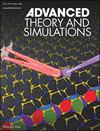Ga, As/Br和部分氢化掺杂Stanene的电子和磁性能:第一性原理计算
IF 2.9
4区 工程技术
Q1 MULTIDISCIPLINARY SCIENCES
引用次数: 0
摘要
Stanene是一种类似石墨烯的二维蜂窝状锡结构,在电子应用中具有诱人的性能。在自旋极化近似的框架下,利用密度泛函理论(DFT)报道了掺杂镓、溴和砷对stanene和部分氢化stanene结构稳定性、电子和磁性能的影响。Stanene是一种类似石墨烯的二维材料,具有半金属性质,掺杂和氢化是一些关键的工程技术,其带隙与计算的掺杂结构参数与先前的工作非常一致。研究表明,掺杂、氢化stanene、氢化Br掺杂和氢化共掺杂的Ga/Br相对于其计算的内聚能是热力学稳定的。原始的斯坦烯单层,它是非磁性的,计算出的带隙能量为零。掺杂剂对stanene的影响表现为金属(M)、半金属(HM)和半导体特性,带隙开口在0.010 ~ 0.202 eV之间可调。观察到所有氢化stanene都是自旋极化的,类似地,Br‐,Ga‐,As/Br和Ga‐As/Br掺杂诱导的磁矩范围在0.02 ~ 0.53 uB之间。结果表明,stanene及其相应的加氢材料可以作为纳米电子和自旋电子器件的潜在候选材料。本文章由计算机程序翻译,如有差异,请以英文原文为准。

Electronic and Magnetic Properties of Ga, As/Br and Partial‐Hydrogenation Doped Stanene: First‐Principles Calculations
Stanene, a graphene‐like 2‐D honeycomb structure of tin has attractive properties for electronic applications. The effect of doping Gallium, Bromine, and Arsenic on the structural stability, and electronic and magnetic properties of stanene and partially hydrogenated stanene is reported using density functional theory (DFT) in the framework of spin‐polarized approximation. Stanene, a graphene‐like 2‐D material with semi‐metallic character, doping, and hydrogenation are some of the key techniques for engineering, its bandgaps with calculated doped structural parameters are in excellent agreement with previous works. The investigation shows that the doped, hydrogenated stanene, hydrogenated Br‐doped and hydrogenated co‐doped Ga/Br are thermodynamically stable with respect to their calculated cohesive energies. The pristine stanene monolayer, which is nonmagnetic, has a calculated zero bandgap of energy. The dopant's effect on stanene shows metallic (M), half‐metallic (HM), and semiconductor characteristics with a tunable bandgap opening ranging between 0.010 and 0.202 eV. It is observed that all hydrogenated stanene are spin‐polarized, similarly Br‐, Ga‐, As/Br, and Ga‐As/Br doping induced magnetic moments ranging between 0.02 to 0.53 uB . The results indicate that stanene and corresponding hydrogenation materials can be potential candidates for nanoelectronics and spintronic devices.
求助全文
通过发布文献求助,成功后即可免费获取论文全文。
去求助
来源期刊

Advanced Theory and Simulations
Multidisciplinary-Multidisciplinary
CiteScore
5.50
自引率
3.00%
发文量
221
期刊介绍:
Advanced Theory and Simulations is an interdisciplinary, international, English-language journal that publishes high-quality scientific results focusing on the development and application of theoretical methods, modeling and simulation approaches in all natural science and medicine areas, including:
materials, chemistry, condensed matter physics
engineering, energy
life science, biology, medicine
atmospheric/environmental science, climate science
planetary science, astronomy, cosmology
method development, numerical methods, statistics
 求助内容:
求助内容: 应助结果提醒方式:
应助结果提醒方式:


